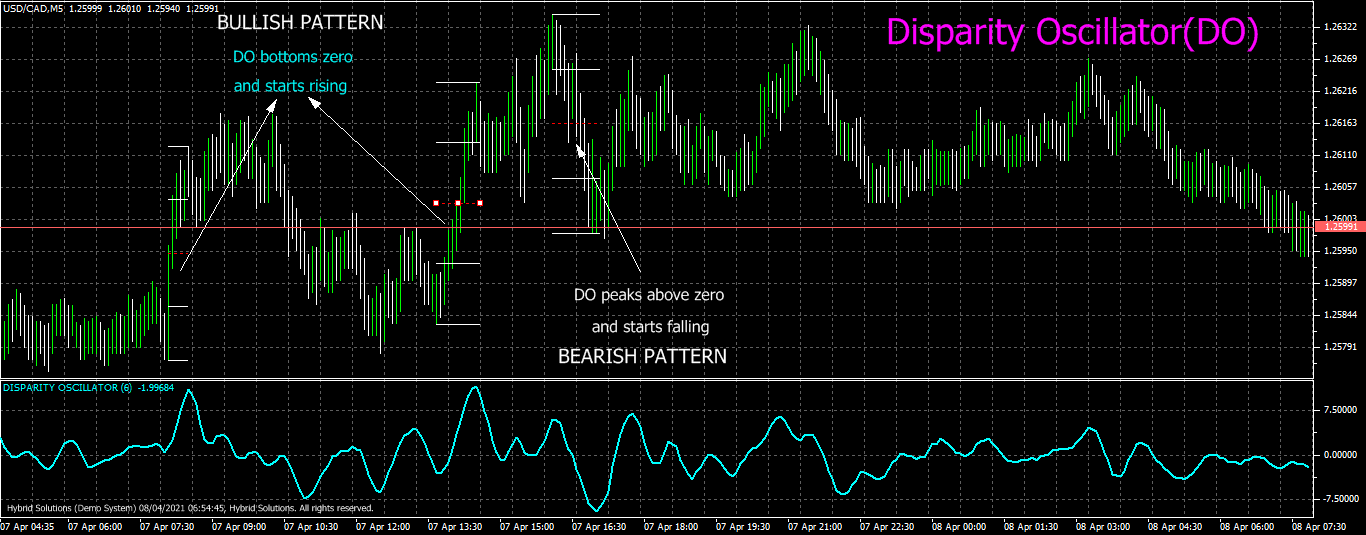$0.00
In stock
The Disparity Oscillator (DO) uses a variation of the Relative Momentum (RM) indicator and the relative change in price to identify whether the current trend is still strong or is nearing exhaustion. Unlike the RM oscillator, the DOuses ananchor bar to calculate the relative momentumwhich is subsequently aggregated. The following steps are employed to calculated the DO,
(Downloads - 552)

Disparity Oscillator is VertexFX indicator that is useful in identifying trend exhaustion and reversals.
The Disparity Oscillator (DO) uses a variation of the Relative Momentum (RM) indicator and the relative change in price to identify whether the current trend is still strong or is nearing exhaustion. Unlike the RM oscillator, the DOuses ananchor bar to calculate the relative momentum which is subsequently aggregated. The following steps are employed to calculated the DO,
a) In the first step we calculate the Disparity Period, which is 1.5 times the input PERIOD, rounded to the nearest integral value. The bar which is Disparity Periodcandles prior to the current (calculated) candles is termed as the Anchor Bar. Assuming the PERIOD is set to 10, then the Anchor Barvalue is 15.
b) In the second step we subtract the current Close from the Close of the Anchor Bar, and divide this by the Close of the Anchor Bar. This is called the Disparity Ratio.
c) This process is repeated for the recent PERIOD candles. Here, it should be noted that the Close of each candle is subtracted from the same Anchor Bar, which is DisparityPeriod candles ago for the current candle.
d) Finally, the sum of all the Disparity Ratios is calculated and divided by PERIOD to derive the DO value.
As the price and momentum slows down, the DO peaks (or bottoms) out in the direction of the trend. This indicates that the market has exhausted and the likelihood of a reversal is very high. As the price starts to move in the opposite direction the DO reverses thereby identifying a bullish or bearish setup.
The DO is a bounded oscillator with a range of -100 to +100. Values above zero are considered bullish and values below zero are considered bearish. Whenever the DO peaks and starts falling, the probability of price falling (bearish) is very high. When the DO bottoms out and starts rising it implies beginning of a bullish trend and the probability of price rising is very high.
Ideally, the DO should be used in conjunction with other trending or oscillator indicators like MACD or Stochastic Oscillators. The trading rule of thumb for using the DO is,
a) LONG – Enter LONG when the DO has bottomed out (two falling DO values, followed by two rising DO values) below zero. The stop-loss can be placed below the nearest Swing Low.
b) SHORT – Enter SHORT when the DO has peaked out (two rising DO values, followed by two falling DO values) above zero. The stop-loss can be placed above the nearest Swing High.
Configurable Inputs
1.PERIOD – The number of (recent) candles used to calculate the Disparity Oscillator values.
Usage
- Download the attachment from vStore or directly from the vStore tab in your terminal by performing a right-click on it and selecting Download & Install
- Copy it to your company VertexFX Local VTL Files folder i.e.C:Users”Username”AppDataRoamingVertexFX Client Terminals“Company name”VTL11Local VTL Scripts
- Restart your Client Terminal or Right Click on “Local VTL Scripts” Tree Node to find the script.
Hindi Version:
Disparity Oscillator वर्टेक्सएफएक्स क्लाइंट-साइड संकेतक प्रवृत्ति थकावट और उलट की पहचान करने के लिए उपयोगी है। Disparity Oscillator (डीओ) संकेतक सापेक्ष मोमेंटम (आरएम) संकेतक की भिन्नता का उपयोग करता है और कीमत में सापेक्ष परिवर्तन यह पहचानने के लिए करता है कि वर्तमान प्रवृत्ति अभी भी मजबूत है या थकावट के करीब है। यह संकेतक सापेक्ष गति की गणना करने के लिए एक anchor बार का भी उपयोग करता है जिसे बाद में एकत्र किया जाता है।
जब स्क्रिप्ट चार्ट से जुड़ी होती है, तो पहले चरण में हम Disparity period अवधि की गणना करते हैं, जो कि पेरीओड पैरामीटर पर इनपुट आयतन 1.5 गुना है, जो निकटतम अभिन्न मान पर आधारित है। वर्तमान मोमबत्तियों से पहले जो बार असमानता वाली मोमबत्तियाँ है, उसे anchor बार कहा जाता है।
दूसरे चरण में, हम एंकर बार के बंद से वर्तमान बंद को घटाकर असमानता अनुपात की गणना करते हैं, और anchor बार के बंद द्वारा इसे विभाजित करते हैं। यह प्रक्रिया हाल ही में पेरीओड मोमबत्तियों के लिए दोहराई गई है। अंत में, डीओ मान प्राप्त करने के लिए सभी असमानता अनुपातों की राशि को पेरियोड द्वारा गणना और विभाजित किया जाता है।
आदर्श रूप से, डीओ का उपयोग एमएसीडी या stochastic ऑसिलेटर्स जैसे अन्य ट्रेंडिंग या ऑसिलेटर संकेतक के साथ किया जाना चाहिए। डीओ का उपयोग करने के लिए अंगूठे का व्यापारिक नियम long अवधि में है जब डीओ शून्य से नीचे चला गया है। स्टॉप-लॉस को निकटतम स्विंग लो के नीचे रखा जा सकता है और यह शॉर्ट में प्रवेश करता है जब डीओ शून्य से ऊपर निकल जाता है। स्टॉप-लॉस को निकटतम स्विंग उच्च के ऊपर रखा जा सकता है।
चार्ट में, एक मंदी सेटअप और दो तेजी सेटअप चिह्नित है। एक मंदी सेटअप तब होता है जब डीओ शून्य से ऊपर की चोटियों और गिरने लगती है।
इसी तरह, तेजी का सेटअप तब होता है, जब डीओ शून्य से नीचे निकल जाता है और ऊपर उठने लगता है। चोटियों या बॉटम्स को न्यूट्रल zero लाइन से जितना दूर करेंगे, मजबूत रिवर्सल की संभावना उतनी ही ज्यादा होती है।
प्रयोग:
विस्टोर से अटैचमेंट डाउनलोड करें या सीधे अपने टर्मिनल में विस्टोर टैब से इसे राइट क्लिक करके डाउनलोड करें और इंस्टॉल करें चुनें।
इसे अपनी कंपनी VertexFX स्थानीय वीटीएल फ़ाइलें फ़ोल्डर में कॉपी करें, अर्थात C:Users”Username”AppDataRoamingVertexFX Client Terminals”Company name”VTL11Local VTL Scripts
अपने क्लाइंट टर्मिनल को पुनः आरंभ करें या स्क्रिप्ट खोजने के लिए “स्थानीय वीटीएल लिपियों” ट्री नोड पर राइट क्लिक करें।
Additional information
| Plugin-Type | Client VTL – Custom Indicator |
|---|---|
| Compatibility |


Reviews
There are no reviews yet.